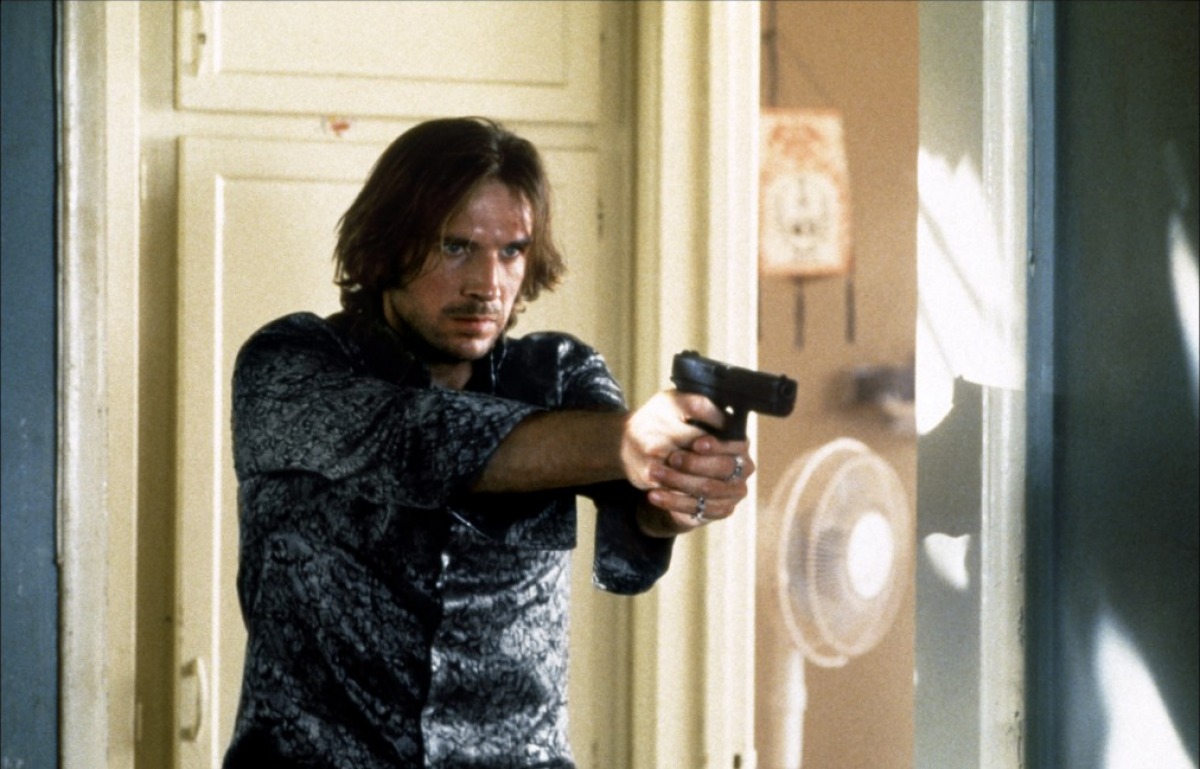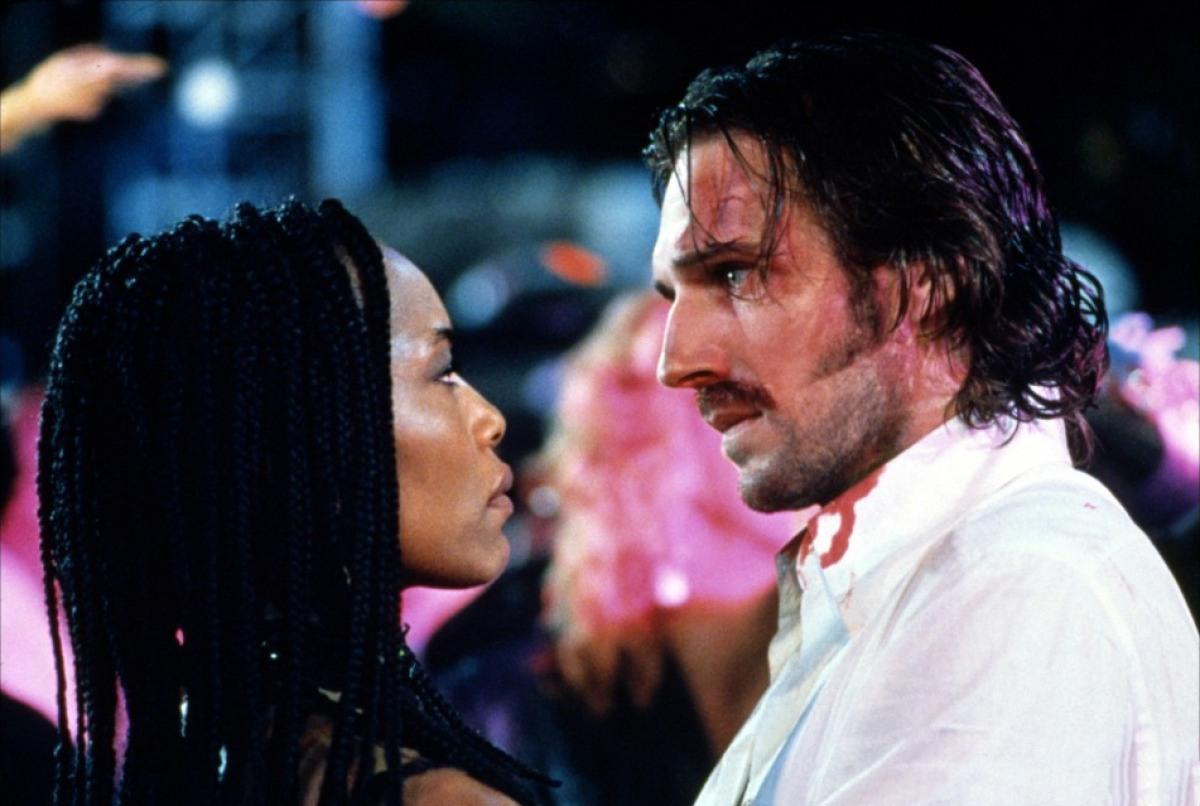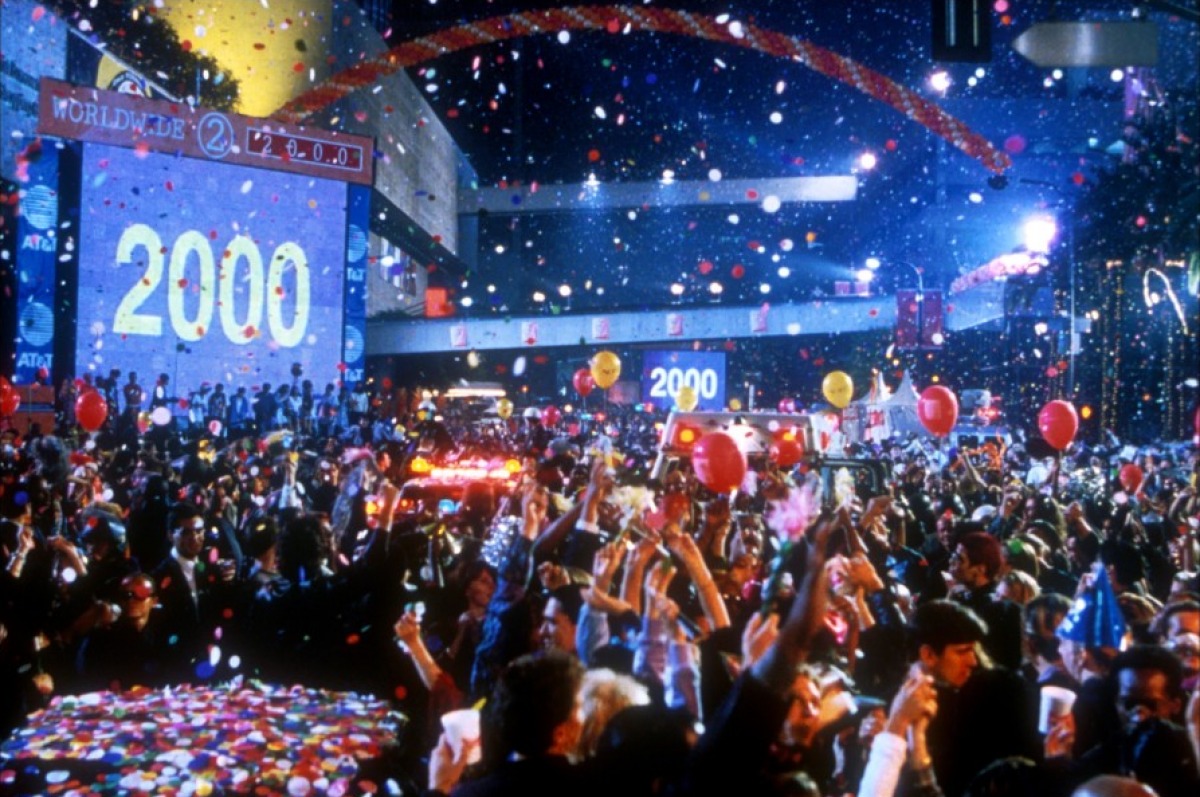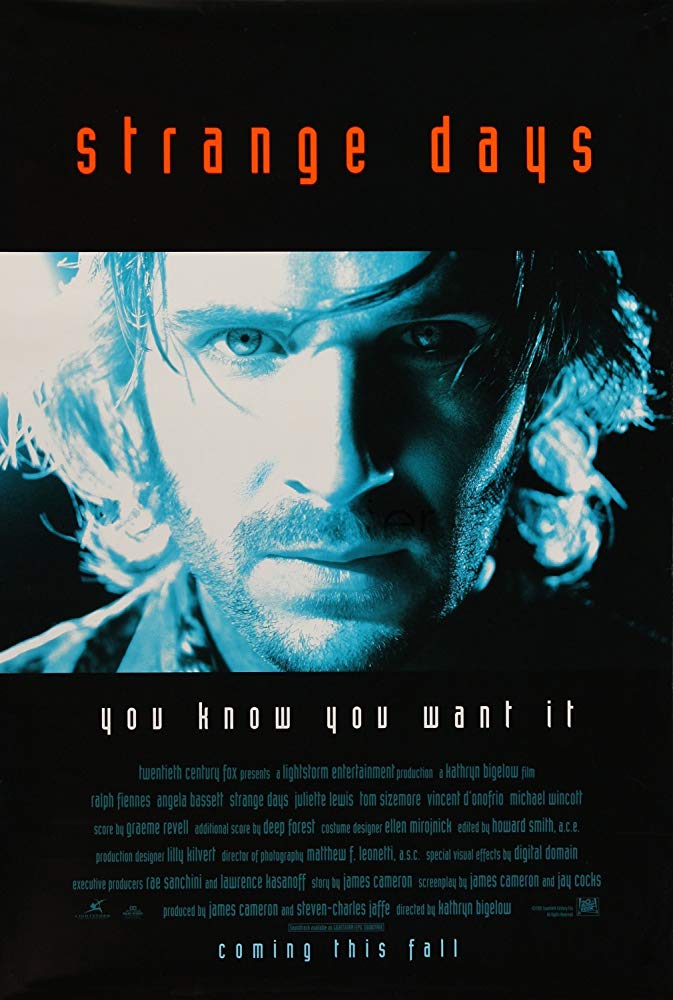Crew
Director – Kathryn Bigelow, Screenplay – James Cameron & Jay Cocks, Story – James Cameron, Producers – James Cameron & Steven-Charles Jaffe, Photography – Matthew F. Leonetti, Music – Graeme Revell, Additional Music – Deep Forest, Visual Effects Supervisor – James Lima, Visual Effects – Digital Domain, Underwater Miniature Effects – Fantasy II Film Effects (Supervisor – Gene Warren Jr), Special Effects Supervisor – Terry Frazee, Production Design – Lilly Kilvert. Production Company – Lightstorm Entertainment.
Cast
Ralph Fiennes (Lenny Nero), Angela Bassett (Lornetta ‘Mace’ Mason), Tom Sizemore (Max Peltier), Juliette Lewis (Faith Justin), Michael Wincott (Philo Gant), Vincent D’Onofrio (Burton Steckler), William Fichtner (Dwayne Engelman), Richard Edson (Tick), Josef Sommer (Comissioner Palmer Strickland), Brigitte Bako (Iris), Glenn Plummer (Jeriko One)
Plot
Los Angeles on December 31st, 1999, the eve of the millennium. Former cop Lenny Nero is a blackmarket dealer in illegal SQUID (Superconducting Quantum Interference Device) tapes that are recorded from human memories. He himself languishes in recorded memories of his former girlfriend Faith Justin, now a famous rock star who wants nothing more to do with him. Lenny is then given a tape that shows two members of the LAPD pulling over and shooting a politically active Black rap artist in cold blood. Lenny learns that they are members of organized death squads within the LAPD who take law into their own hands. However, the existence of the tape now has Lenny targeted by the same killer cops.
It may well be in the end that Cyberpunk proves to be no more than a simple case of future shock, the phrase that Alvin Toffler coined in the 1970s to explain a psychological inability to cope with rapid social change. Fundamental to Cyberpunk are two things. One is a gloomy and uncertain near future that is a close projection of the present, a place where society is caught between either the very rich or the very poor and with nowhere in between, and where the shining designer trappings of capitalism contrast with a teeming street-life and techno-savvy crime.
The second facet of Cyberpunk is an ambiguous view of technology – an uncertainty as to whether it brings transformation or enslavement. Even films like The Lawnmower Man (1992) and Ghost in the Machine (1993), which present views of new technology at their most Luddhite, hypocritically blow all their budgets on eye-expanding displays of cyberspace.
Cyberpunk was very much a mirror of the changes that the Western world underwent from the 1980s onwards. In the 1980s and 90s, the world was economically changed far more than during any other point in history, while at the same time was on the verge of a computer revolution that presented radical changes in the way we communicated, the distribution of information and even what we regard as the very nature of reality. Traditional dystopian science-fiction always had no trouble decrying in loud terms current social trends taken to their extremes. It was is no surprise in the 1990s world of perpetual change that the dystopia became a thing of the past and instead we had Cyberpunk where nobody was sure whether it offered Utopia or Dystopia. It is a prophetic fiction of deep uncertainty.

Strange Days attempts an audacious conceptual straddle. It juggles a plot that ranges from being a whodunnit, an examination of racial tensions within contemporary America, an exploration of the moral questions represented by virtual technologies, the coming anxiety of the millennium and last, but not least, is a romance. That the film takes 2½ hours to cover all of this is no particular surprise.
Strange Days offers a disturbing portrait of American society of the very near future verging on imminent collapse – open anarchy in the streets, race riots and corrupt police violence. One sequence near the beginning, a slow-motion view looking out from Ralph Fiennes’s car as he cruises through the street showing burning cars, armoured police vehicles and senseless violence, including hoods beating up a Santa – is dazzling. It is like a vision of the future created by someone who has lived in South Central L.A. all of their lives.
And if one wants to see how alarmingly close to the bone such a vision was, one need to look no further than the fact that Strange Days opened the same day as the verdict for the O.J. Simpson trial was announced, the entire defence strategy of which seemed to consist of swinging the trial’s focus around to point at a deep racist streak within the LAPD, something that was not that far removed from Strange Days‘s vision of corrupt cops picking on a successful Black public figure.

Strange Days was a strong return to form for Kathryn Bigelow. Kathryn Bigelow made an extraordinary explosion onto the genre scene with Near Dark (1987), surely the most dazzling and original reinvention of the vampire myth conducted in the 1980s. Unfortunately, Kathryn Bigelow’s subsequent films – the psycho-thriller Blue Steel (1990) and and following this, the historical murder mystery The Weight of Water (2000) and the submarine drama K19: The Widowmaker (2002) – met with uneven box-office reception, the sole one not to do so being the amazingly silly skydiving/surfing bank robbers film Point Break (1991). That is, until she returned to form with the highly acclaimed The Hurt Locker (2008), which netted her an Academy Award as Best Director, followed by Zero Dark Thirty (2012), Detroit (2017) and the nuclear war film A House of Dynamite (2025).
With Strange Days, Kathryn Bigelow has the backing of her former husband James Cameron, no less than the director/writer of The Terminator (1984), Aliens (1986), The Abyss (1989), Terminator 2: Judgment Day (1991), Titanic (1997) and Avatar (2009), on script. Strange Days was not Kathryn Bigelow’s first dalliance with Cyberpunk – she has had an active interest in the subject and was once to have made a film of Cyberpunk godfather William Gibson’s short story The New Rose Hotel (1981) – later filmed by Abel Ferrara as New Rose Hotel (1998) – and was one of the four directors on tv’s excellent Cyberpunk mini-series Wild Palms (1993), while her first film job was an acting appearance in Lizzie Borden’s feminist dystopia Born in Flames (1982).
James Cameron is a director/writer with a rare intelligence. He creates massive action and special effects films but ones that also have a solidly human core to them. Cameron, co-writing here along with Time magazine film critic Jay Cocks, creates an impressive film. Strange Days is a long film, perhaps a little too long. However, Cameron and Cocks cover much, including questioning the central technology with an uncommon sensitivity – Ralph Fiennes’s sales pitches for it are persuasive but the film also makes strong moral points about the technology’s usage. It is perhaps no surprise coming from James Cameron that the end of the film has Ralph Fiennes abandonment virtual memories in favour of real love. The triumph of the human is always at the centre of Cameron’s films and Strange Days offers up the hope of a real vs a virtual relationship as making the difference in a world going to hell in a hand-basket. (This is not unlike Cameron’s The Abyss where Cameron also seeks hope and salvation inside a relationship).

On the other hand, the climax the film reaches feels a little false – the hero rejects virtual reality in favour of the real relationship under his nose and the corrupt cops are arrested. However, nothing is done to save the world around him and heal the deep racial divide the film exposes. Perhaps it is Kathryn Bigelow’s fault that she creates such a grim and overwhelming vision of the world that such an ending seems trite. (One also fails to believe that such advanced technology would be in street usage by the turn of the millennium, a mere five years from the time the film was made).
Kathryn Bigelow makes riveting use of handheld camera throughout. Unlike most Virtual Reality films, she makes the logical choice of showing the memory playbacks completely from a first-person camera point-of-view. The long scene involving the murder of Jeriko shot in first person camera is absolutely riveting. There is also a fabulous sequence that opens the film of a playback of a robbery, which contains a dizzying jump between buildings and a landing on fingertips on the roof’s edge, all conducted via subjective point-of-view camerawork.
(Nominee for Best Original Screenplay and Best Actress (Angela Bassett) at this site’s Best of 1995 Awards).
Trailer here


